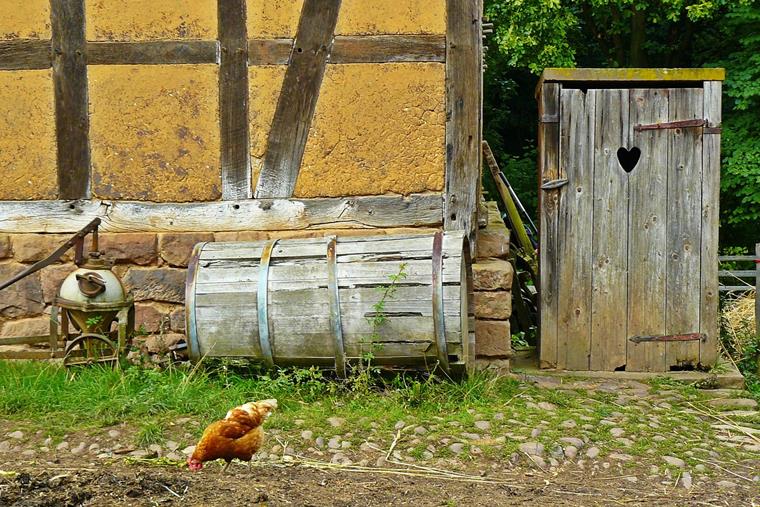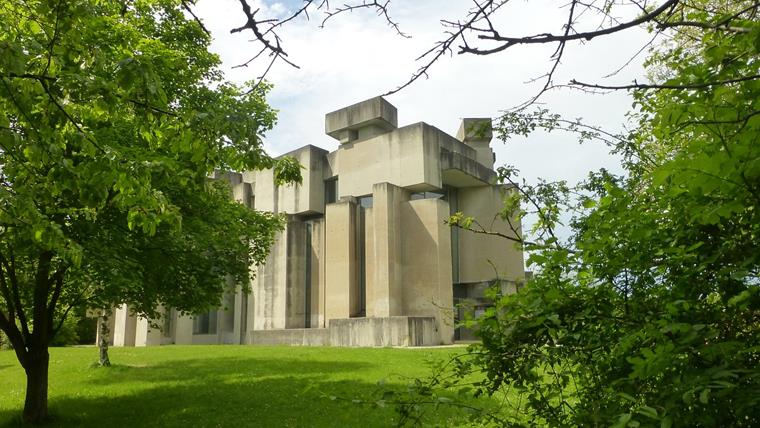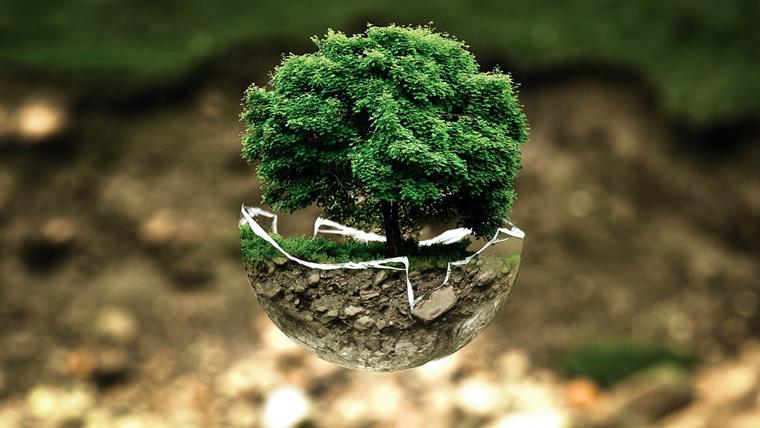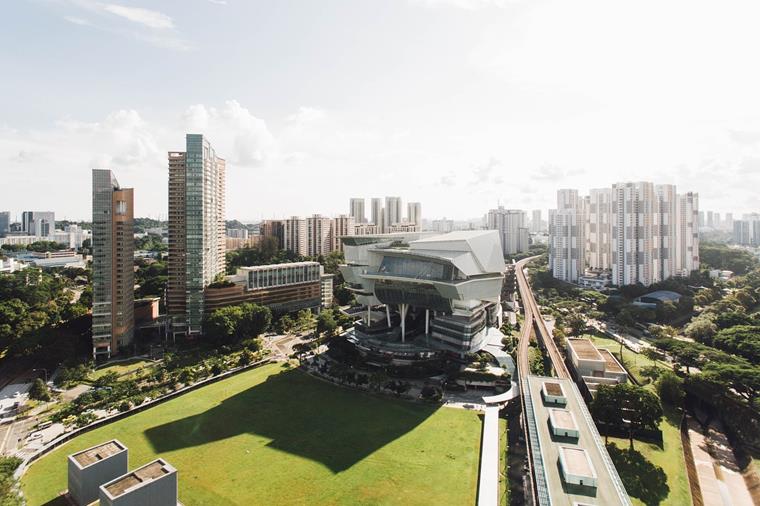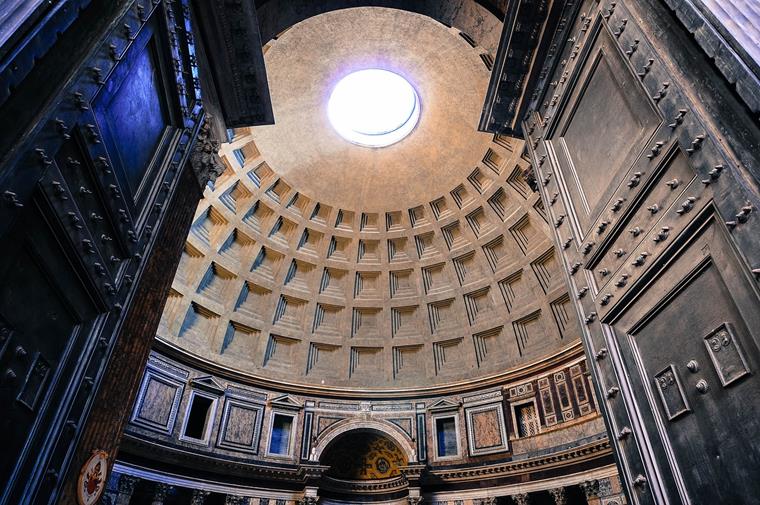Building – But Sustainably
Andrea is a civil engineer and works as a consultant for age-appropriate building. Already during her studies at the Technical University of Munich, she deepened the issue of sustainable building. Now, she is particularly concerned with the "cradle-to-cradle" principle. The aim is to achieve a cycle of raw materials.
This helps, for example, to save CO2 that is generated in the production of concrete, for example. We finally have to start seeing a building not as a final storage, but as an intermediate storage for raw materials, and to deal more consciously with the ones we have. Recycling is the big goal – and so it is in the construction industry as well.
"When designing building materials and buildings, we have to design the whole thing for the cycle."
Cradle to Cradle in Construction?
Cradle-to-cradle is not just about sustainability, but above all, about health. We spend about 90% of our day indoors. The fact is that the air is often worse there than on a busy road. Why?
The reason for this are is exhalations of the used materials, which can even make us ill. With a number of suppliers and supply chains, manufacturers often do not know exactly what is contained in their products.
A guarantee of a good indoor climate is, for example, the use of clay in the interior. The best: clay is thoroughly reusable. If you want to read more about clay as a building material, we recommend you the following blog post:
Clay as Sustainable Building Material
It is also necessary to consider the social aspects. This includes, for example, the water cycle. Water used for production should not just disappear, but should be recycled, if possible. Biodiversity is exactly an issue. Construction projects must not lead to nature suffering as a result. By creating outdoor facilities and open spaces, we can ensure that the animals and plants are preserved.
In summary, cradle-to-cradle is about creating optimal conditions for people in the interior as well as for the environment. Due to the often long service life of buildings, it is important that there is a space left for flexible conversion when building sustainably.
Since walls can be dismantled, for example, it should be possible to change the floor plan at any time without using additional materials or completely dismantling the building. Because the necessary conversions for a change of use are often the only reasons for the demolition of a building.
“Most of the buildings are not demolished, because the building materials are at the end of their useful life."
Sometimes, the times are changing and a building simply no longer fits the environment. Customization is another important point that should be paid more attention in the construction industry. A sustainable building must be adaptable. As engineers, we have a great responsibility when planning buildings – towards both our environment and our fellow human beings.
Architects for Future
Alliance for Sustainability in Construction
You may know for sure the popular movement "Fridays for Future", where students staged school strikes to raise the awareness of the consequences of climate change and to acknowledge the urgent need for action. There is also a very similar movement in the construction industry: "Architects for Future". Andrea is a member and tells us a little about it.
In fact, this movement includes all participants in the construction industry, and not just architects. However, it was the latter who initiated this organization and the name was simply left as it was. Since 2019, the movement has been working in solidarity with Fridays for Future for compliance with the Paris Agreement.
Whether clay structures, timber structures, or the location of single-family houses: the initiative deals a lot with research and preparation relevant topics related to sustainability and the circular economy in construction. Andrea herself mainly takes care of public relations, that is, interviews or podcasts on the subject of cradle-to-cradle in the construction industry. Furthermore, she coordinates most of the regional groups in Bavaria.
An important goal is not only to point out mistakes in the construction industry, but to motivate it to change itself from the inside. However, the main work of the initiative is taking place more at the political level. For example, they have submitted applications to the Federal Republic of Germany, proposing changes to the building regulations. Because the construction industry is not reacting to the topic of sustainability by itself, or only in small parts.
"We've tried appealing to a guilty conscience long enough. That doesn't help at all as long as climate-damaging construction is cheaper than proper building."
Therefore, for the first time, all stakeholders involved in the construction industry are expected to work together in the name of the "Architects for Future" initiative to make joint demands of Germany. Whether consulting engineers, the Federal Association of Bavarian Architects, or the construction industry itself: All unite and fight together to come a step closer to the goals of sustainability, cradle-to-cradle, and environmental protection in the construction industry.
Above all, they are committed to six necessary immediate measures that should be implemented as soon as possible in order to meet the climate goals of the Paris Agreement. She briefly presents them to us in the interview.
BIM as Standard
BIM should become the standard for suitable projects. Of course, it's not worth it in the case of single-family houses, as they are simply not complex enough for such software. However, BIM has numerous advantages, especially for large state projects.
Architects, for example, often use BIM software to model the buildings; after all, it's much easier that way. However, we often encounter the first problem here: BIM requires digitization, of course. And that seems to be a particularly long time ahead in the construction industry. That has to change.
Circular Economy
The Bavarian Cycle Act states that the public has a special responsibility to set an example when it comes to sustainability. For example, state projects should set an example that raw materials can be recycled.
Anyone who knows the construction industry, especially state construction projects, knows: this doesn't happen there. We continue to rely on proven methods. Despite the legal regulation, there are no controls or consequences if the developer does not comply with these rules. In public tenders, sustainable methods and materials are even actively excluded. Again, there is an urgent need for action.
Sites for Recycling Building Materials
In order to be able to implement our climate goals, we not only need recyclable raw materials, but also easily accessible locations where this recycling process can be carried out. Similarly to what is already done with recycling yards for household waste, such as defective appliances or bulky waste.
After all, what use is a central location for building material recycling if the access routes lead to more environmental pollution and higher costs? It is also necessary to plan more here in order to ensure that the recycling of construction projects is even feasible economically in practice.
Life-Cycle Based Planning
This topic is particularly important for public construction projects. Because the large planned structures are often built with our tax money. Anyone who is familiar with this topic knows the high costs that are caused when a building is not built really adaptable. In such cases, the modernization costs are often very high.
For conversion, the majority of the building material has to be removed from most public buildings and usually ends up in landfills. As taxpayers, we also have to bear the costs. Therefore, it would only be fair to us not just to keep an eye on the investment costs, but to think long-term and prioritize the life cycle costs. Because that's what matters in the end.
Promoting Innovation and Sustainability
Innovative ideas in particular help us to keep developing. They are also indispensable when it comes to climate issues. There is only a negligible number of real innovations in the construction industry. Among other things, this is due to the fact that innovative projects and building materials are not sufficiently funded. The whole process takes far too long.
Something should be done on the level of politics, for example, to ensure that the alternative, more sustainable building materials become a real competitor for conventional climate killers. An example of an innovative building material is carbon concrete. If you are interested in the topic, read on here:
Building with Carbon Concrete
Andrea mentions the Sponge City principle and the blue-green infrastructure as an example of the innovative climate adaptation. Due to the climate change, cities are often prone to severe storms and the associated floods. Large parts of public space in cities are simply sealed by paving or concrete. One measure to counteract this is the creation of so-called "sponge cities".
Here, surfaces are created within cities to absorb all the rainwater and then slowly release it again. Lower overlying infiltration basins or green roofs make a big difference here.
The water is temporarily stored there, of course, and does not all of a sudden flow into the drains or the ground water. Furthermore, these surfaces provide measurable cooling in summer, and the city trees, which often find their place in these hollows, survived the hot days without any problems.
Public Education on Sustainable Building
As the last important point, she mentions the public handling of these issues. Something like this can only work if the public is informed about it. This information must be comprehensible and handed over at the right speed, so that as many people as possible can understand the need for such measures.
“Only if you take everyone with you, can this transformation succeed."
Cradle to Cradle in Practice
Andrea has designed her own house – according to the cradle-to-cradle principle, of course. Therefore, we ask directly. Her biggest challenge, as she tells us, was the entire planning, which she did completely herself. As a civil engineer, the structure wasn't a big problem, of course, but then it came to the interior design and she realized that there was a lot more to learn than she would have thought.
Moreover, it is relatively difficult to find companies that want to and are able to participate in the realization of such a project. Because innovative building materials or methods are not yet too widespread in the construction industry. The legal side in particular, that is, the extension and creation of new standards, is often a long time coming.
Therefore, many papers had to be signed that full responsibility was taken in case of problems. Here, Andrea recommends future house builders to document everything, to plan well in advance and, above all, to bring enough time with them.
Future of Construction
Of course, we also ask Andrea how she sees the future of the construction industry. She has a very clear opinion on this, which we can understand, based on the figures and information she has mentioned.
"Either everything will be implemented in a circular and sustainable way, or we will probably die out."
A very devastating verdict, but realistic nonetheless. After all, in the construction industry, we usually work with raw materials that are far too polluting. If we do not change this, climate change will eventually ensure that parts of the earth are no longer livable and that people will have to flee to other parts. War for water, war for food: It would end in chaos.
Andrea assumes that prefabricated buildings and renovations of existing buildings will account for a larger market share in the future. As the background to this, she cites, for example, the shortage of skilled workers, which will make automated prefabrication indispensable. If you are interested in modular or prefabricated construction, have a look here:
Modular Construction as Sustainable Future?
She sees a lot of catching up to do in terms of sustainability in the construction industry and building redevelopment, especially in education or training. She sees the most responsibility in the current political framework conditions. Concrete is still much cheaper to purchase and process than timber, for example, that has to change. She has a clear message for all future engineers:
“Just dare to try new things and have the courage to assert yourselves against those who say, no, we have always done it this way. It's worth it."
Andrea, what is your favorite building?
Before, she tells us, it was the Pantheon. With numerous structural tricks, the people at that time managed to have the largest dome in the world for two thousand years. This was an enormous and impressive achievement for the possibilities at the time.
Meanwhile, she admits, her favorite building is clearly her own house, which she designed and had built according to the cradle-to-cradle principle. We can fully understand that, of course. Thank you for being with us, Andrea!
Would you like to listen to the full episode? You can find it here:

